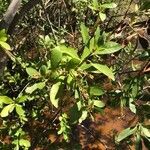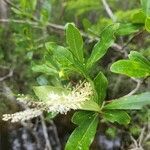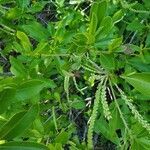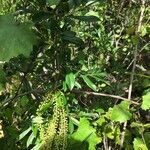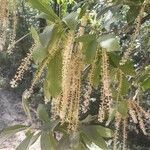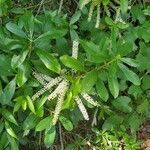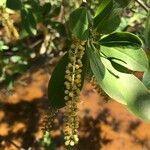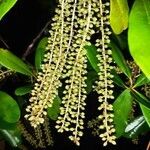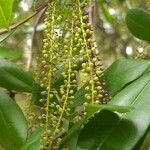Shrub or small tree, up to 7-15 m tall, sometimes multistemmed, occasionally spreading with vine-like branches, rarely branched at base. Leaf scars prominent. Stipules inconspicuous (caducous) or absent; petiole usually short (nearly subsessile), slightly winged, 0.4-1.3 cm long; blade subcoriaceous to coriaceous, oblanceolate to elliptic, occasionally linear, 2-11(-12) (including petiole) x 0.4-2.5(-3) cm, margin usually slightly reflexed, apex acute to rounded, sometimes emarginated (rarely apiculate), base narrowly cuneate to attenuate; midvein generally depressed above, prominent beneath, densely reticulate, slightly prominent or obscure above, secondary veins straight to slightly arcuate, divergent, irregularly anastomosing. Inflorescence racemose, axillary, usually near end of branches, glabrous; peduncle 0.4-1.7 cm long (before the first bract); rachis up to 14 cm long, usually somewhat ridged; often numerous flowers, erect or pendulous; bract lanceolate-subulate, 0.8-2.4(-3.5) mm long, acuminate to very acute, basally thickened and usually costate, persistent; bracteoles 2, usually above middle of pedicel, alternate or opposite, lanceolate, 1-1.5(-1.6) mm long, persistent; pedicels ascending or slightly patent, alternate or subopposite, 1.1-2 mm long (up to 4 mm when fruiting), usually pink. Flowers actinomorphic; sepals free, or basally connate, 5, pink, coriaceous, usually with basal thickening, lanceolate-ovate to deltoid, 0.6-1.5(-1.6) x up to 0.7(-1) mm, apex acute to acuminate, glabrous, persistent; petals imbricate or slightly contorted, free or shortly fused, 5, white, usually more membranaceous along margin, oblong to oblong-lanceolate or oblong-elliptic, 2(-2.4) x up to 1.1 mm, margins sometimes inrolled (giving the appearance of long acuminate), apex acute, obtuse or rounded, glabrous to rarely glandular on lower inner surface; stamens 5, about 2/3 as long as petals (always shorter), filaments flattened, 1.1-1.4 mm long, anthers terete, linear-subulate, up to 0.4 mm broad, very occasionally with mucronate tip, versatile, dehiscing longitudinally, pink or purple; nectary disc sometimes present; ovary 2-3(rarely-4)-locular, oblong to slightly ovate, wrinkled when dried, glabrous, up to 1.6(-2) mm long, ovules usually 2, pendulous from apex of locule, style 1, short, stout, stigma entire, or 2-3-lobed, corresponding to number of locules. Fruit dry, indehiscent, green immature, red (pink) at maturity, subglobose to globose or conic-ellipsoid, 2.5-(3) x up to (0.9-)2(-3) mm, usually smooth (rarely slightly rugulose), glabrous, stigma usually persistent; seeds 1 per locule, elongate.
More
Trees (in Panama) with thick, rough, brown bark; diam ca 45 cm; branches glabrous, terete; branchlets subterete to angulate, glabrous. Leaves crowded towards the ends of the branches, the blade oblanceolate, narrowly cuneate at base, acute to subobtuse at apex, recurved marginally, coriaceous, glabrous, the midvein prom-inent beneath, densely reticulate, 2-9 cm long, 1-2.4 cm broad; petiole to! 4 mm long, glabrous. Racemes 3.5-1.0 cm long, borne in the upper axils, erect to pendu-lous, glabrous; peduncles 4-10 mm long, glabrous; bracts 0.5-1.5 mm long, lance-olate, glabrous, persistent, ascending in bud, spreading to descending after anthesis. Flowers ascending in bud, spreading at anthesis, pedicellate, the pedicel 1-2 mm long, glabrous; bracteoles paired, alternate to opposite, 0.5-1 mm long, lanceolate, basally thickened, usually persistent, borne above the middle of the pedicel, spread- ing after anthesis; sepals 5, free, ovate-lanceolate to deltoid, acute at apex, 0.4-0.7 mm long, imbricate in bud; petals 5, inserted on a small glandular disk, o0blong-lanceolate to oblong-elliptic, acute at apex; stamens opposite the petals, 1.5-2 mm long, the filaments terete, the anthers versatile; ovaries sessile, 2-3(-4)-locular, the style persistent, the stigma 2-4-lobed. Fruits dry, globose, ovoid to oblong-ovoid, 1.6-2.7 mm in diam; seeds elongate; cotyledons short, inferior; radicle superior.
Shrub or small tree to 10(–20) m; lvs leathery, persistent through much of the winter, oblanceolate to obovate, 5–10 cm, the petiole 5–8 mm; racemes several, borne just below the leafy branches of the season, spreading, slender, 6–15 cm, floriferous to the base; bracts subulate, equaling or longer than the pedicels; pet white, oblanceolate, 3 mm, slightly surpassing the stamens; fr gray, round-ovoid to depressed-globose, 2–3 mm, excluding the persistent short, 2–3-lobed style; 2n=40. Swamps and wet woods on the coastal plain; se. Va. to Tex., s. into n. S. Amer. June.
Plants to 10 m, frequently forming dense thickets. Leaves: petiole distinct; blade green, oblanceolate to elliptic, 1-10 × 0.5-2.5 cm, chartaceous to coriaceous, base cuneate, apex acute, rounded, or emarginate. Flowers fragrant; petals white or creamy white, 2.5-3.5 mm. Fruits ovoid to subglobose, 2-2.5 mm.
